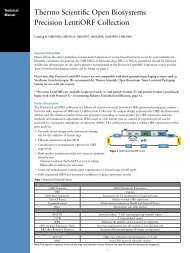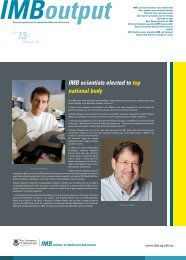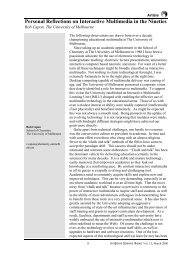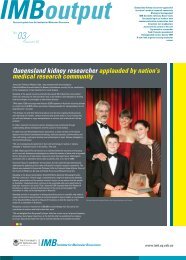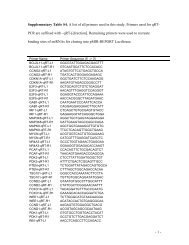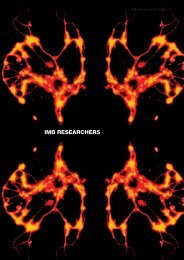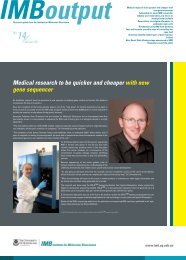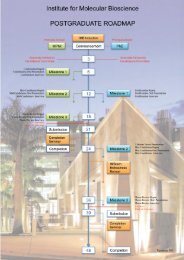2010 Annual Report - Institute for Molecular Bioscience - University ...
2010 Annual Report - Institute for Molecular Bioscience - University ...
2010 Annual Report - Institute for Molecular Bioscience - University ...
You also want an ePaper? Increase the reach of your titles
YUMPU automatically turns print PDFs into web optimized ePapers that Google loves.
99 glossary<br />
Glossary of terms<br />
Actin A protein, along with myosin,<br />
responsible <strong>for</strong> muscle contraction.<br />
Adipose Fat or fatty tissue.<br />
Agonist A molecule that interacts with a<br />
receptor, triggering a cellular response.<br />
Agrochemicals Chemicals used in<br />
agriculture.<br />
Allele Different varieties of a gene that<br />
produce different traits.<br />
Allosteric A site on a protein that isn’t<br />
active.<br />
AMPK An enzyme involved in the<br />
maintenance of cellular energy.<br />
Amyloid A type of protein deposited in<br />
organs in certain diseases. eg. amyloid<br />
deposits are found in the brain of<br />
Alzheimer’s patients.<br />
Antagonist A molecule that blocks a<br />
chemical from binding to its receptor.<br />
Apoptosis Programmed cell death.<br />
Aromatase An enzyme that causes<br />
testosterone to trans<strong>for</strong>m into estrogen.<br />
Arrays An ordering of samples on a slide.<br />
Assay Qualitative or quantitative analyses<br />
of a substance per<strong>for</strong>med in order to<br />
determine its components.<br />
Atherosclerosis A disease in which<br />
cholesterol builds up on artery walls,<br />
causing the arteries to narrow.<br />
BAC recombineering A method of<br />
introducing genetic material into an<br />
organism through a bacterial vector.<br />
Beta-adrenergic Receptors in the<br />
nervous system that sense hormones<br />
such as adrenaline.<br />
Bioactive Has an effect on a living<br />
organism.<br />
Bioin<strong>for</strong>matics The use of<br />
computational resources in the study of<br />
biological in<strong>for</strong>mation.<br />
Biomolecule Molecules containing<br />
carbon found in living organisms.<br />
Biophysical The intersection between<br />
physics and biology.<br />
Bioprobes A probe containing<br />
biomolecules that measures some type of<br />
biological phenomena.<br />
Biosynthesis The production of material<br />
from living organisms.<br />
Chondrogenesis The development of<br />
cartilage.<br />
Chromatin The complex of DNA and<br />
proteins that <strong>for</strong>m a chromosome.<br />
Chromosome A long coiled strand of<br />
DNA, wound around a protein.<br />
Chromotographic Involving the<br />
separation of compounds into their<br />
constituent parts.<br />
CNV Copy number variant. A sequence of<br />
DNA that is repeated a different number of<br />
times in different genomes.<br />
Coculture A culture (preparation) in<br />
which more than one type of cell is grown.<br />
Conotoxins Toxic peptides from marine<br />
cone snail venom.<br />
Covalent A bond in which electrons are<br />
shared between atoms.<br />
Crystallography The use of X-rays to<br />
determine the structure of crystallised<br />
molecules.<br />
Cytokines Small proteins released by<br />
cells that affect the behaviour of other<br />
cells.<br />
Cytoplasm All the contents of a cell,<br />
excepting the nucleus.<br />
Cytoskeleton The protein framework of<br />
a cell.<br />
Cytotoxicity Toxic to cells.<br />
De novo Not previously present.<br />
Differentiation The process by which<br />
cells become more specialised.<br />
Diffraction The scattering of light waves<br />
as they pass through or around an object.<br />
DNA Deoxyribonucleic acid. The chemical<br />
chain that carries the genetic instructions<br />
<strong>for</strong> making a living organism.<br />
Dyslipidemia A disorder that occurs<br />
when there is an excess of lipids in the<br />
blood.<br />
Effector complexes A molecule that<br />
alters the activity of a protein by binding<br />
to it.<br />
Electron tomography A microscopy<br />
technique that samples a specimen at<br />
different angles and builds the resulting<br />
in<strong>for</strong>mation into a 3D image.<br />
Embryogenesis The development of an<br />
embryo.<br />
Endocrine A system of glands that<br />
secrete hormones directly into the<br />
bloodstream.<br />
Endocytosis Uptake of material into a<br />
cell.<br />
Endogenous Within the body.<br />
Endosomes An organelle involved in<br />
protein trafficking.<br />
Enzymes A protein produced by living<br />
organisms that catalyses chemical<br />
reactions of other substances without<br />
being altered itself by the reactions.<br />
Epifluorescence A type of microscopy<br />
using a very bright light source. This light<br />
is used to energise the sample into reemitting<br />
light (or “fluorescing”) at various<br />
wavelengths, which allows researchers to<br />
produce an image of the sample.<br />
Epigenetic The changes in phenotype<br />
that occur without a corresponding<br />
change in genotype.<br />
Epigenomic A cataloguing of the nongenetic<br />
changes that occur in the genome<br />
that affect gene expression.<br />
Epithelial Of the membranous cellular<br />
tissue that covers the internal and external<br />
surfaces of the body.<br />
Epitopes The site on the surface of<br />
a <strong>for</strong>eign substance that triggers the<br />
production of antibodies, and to which<br />
these antibodies bind.<br />
Erythropoiesis The development of<br />
mature red blood cells.<br />
Eukaryotes Organisms whose genetic<br />
material is enclosed in a membranebound<br />
nucleus. Includes all organisms<br />
except viruses and bacteria.<br />
Ex vivo Taking place outside an<br />
organism.<br />
Exocytosis The discharge of material<br />
from the cell.<br />
FACS Fluorescent-activated cell sorting. A<br />
method of sorting a heterogeneous group<br />
of cells using the light scattering and<br />
fluorescent characteristics of each cell.<br />
Flavivirus One of a family of small RNA<br />
viruses that are often transmitted by<br />
mosquitoes and ticks.<br />
Gastrulation An embryonic stage of<br />
development where the embryo turns from<br />
a blastula (ball of cells) into three layers of<br />
cells, from which organs develop.<br />
Gene Considered the basic unit of<br />
heredity, a gene is a region of DNA that<br />
encodes all of the in<strong>for</strong>mation to make a<br />
protein.<br />
Genome All DNA contained in an<br />
organism or cell.<br />
Genotype The specific set of alleles<br />
possessed by an individual, either in<br />
whole or at one loci.<br />
Globin The protein component of<br />
haemoglobin.




